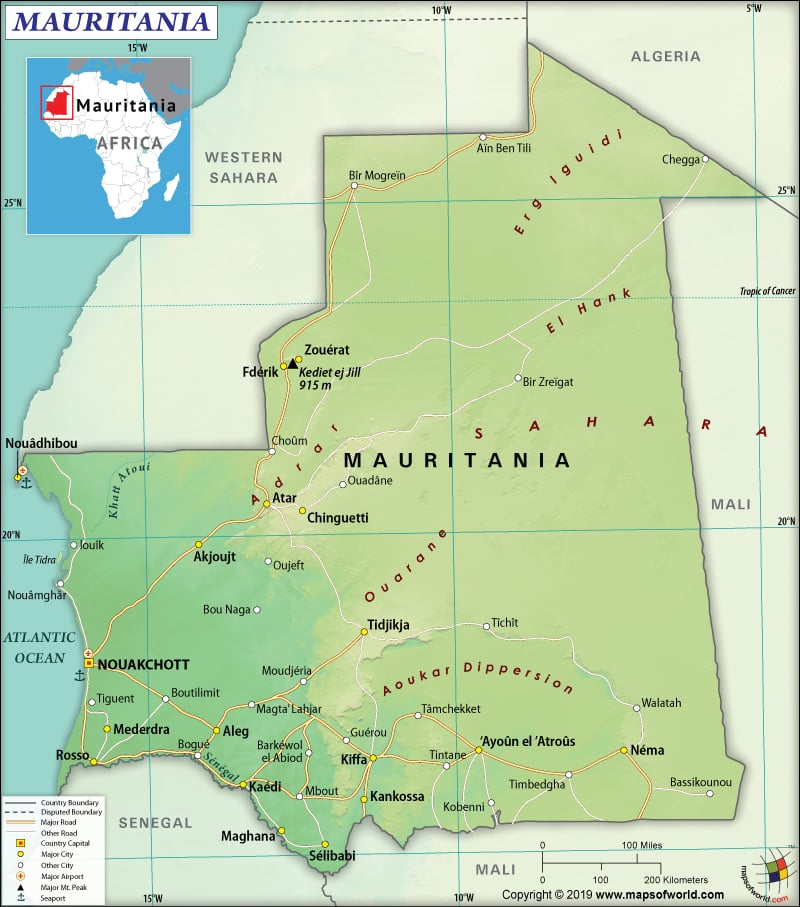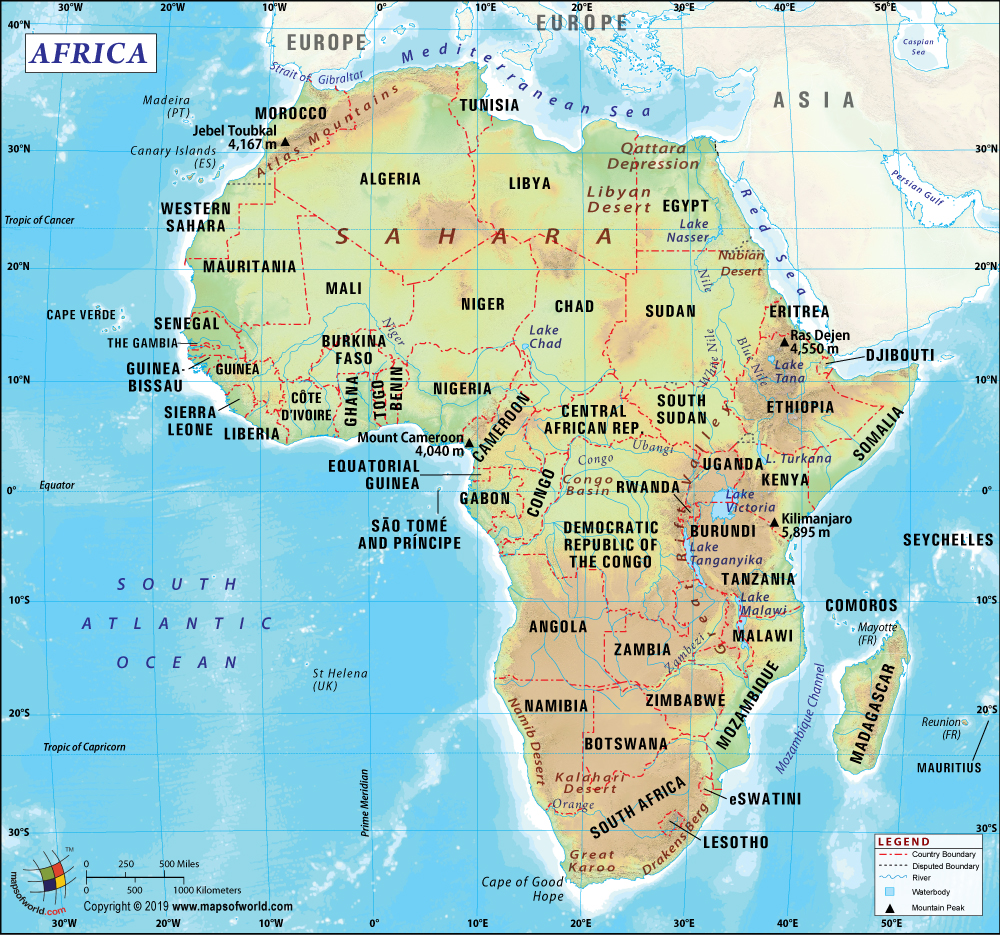What are the Key Facts of Mauritania?

|
Official Name |
Islamic Republic of Mauritania |
|
Continent |
Africa |
|
Capital |
Nouakchott |
|
Largest City |
Nouakchott |
|
Coordinates |
20.000000, -12.000000 |
|
Area |
400,000 sq. mi ( 1,030,000 sq. km) |
|
Land Boundaries |
3,108 mi (5,002 km) |
|
Coastline |
469 mi ( 754 km) |
|
Currency |
Ouguiya (MRU) |
|
Neighboring Countries |
Western Sahara, Algeria, Mali, Senegal |
|
Population |
4,403,313 (2018 est. ) |
|
Official Languages |
Arabic |
|
Major Religion |
Islam |
|
National Day |
28 November (Independence Day) |
|
National Anthem |
“Hymne National de la Republique Islamique de Mauritanie” |
|
Form of Government |
Unitary semi-presidential Islamic republic |
|
President |
Mohamed Ould Ghazouani |
|
Prime Minister |
Yahya Ould Hademine |
|
GDP per capita (PPP) |
$ 4,190.0 (World Bank, 2018) |
|
GDP per capita (nominal) |
$ 1,218.6 (World Bank, 2018) |
|
HDI |
0.52 (2017), Rank: 159 |
|
Literacy Rate (%) |
53.50 (UNESCO, 2017) |
|
Space Agency |
NA |
|
Military Expenditure Ranking |
117 (SIPRI, 2017) |
|
No. of Olympic Medals |
0 (as of 2018) |
|
Driving Side |
right |
|
Calling Code |
+222 |
|
Time Zone |
UTC+0 (GMT) |
|
Internet TLD |
.mr |
Where is Mauritania?
Mauritania is located in Northwest Africa. It shares its borders with Senegal to the southwest, Mali to the east and southeast, Algeria to the northeast, Western Sahara to the north and northwest, and the Atlantic Ocean to the west.
What is the Geography of Mauritania?
Mauritania is one of the largest countries in Africa. It is spread across a total area of 1,030,700 sq. km (400,000 sq. mi), out of which 1,030,700 sq. km (400,000 sq. mi) is land area and 0 sq. km (0 sq. mi) is water area.
Here is Mauritania Physical Map showing all physical feature of the country.
It has a 5,002 km (3,108 mi) long land boundary, which is shared with four neighboring countries or territories: Mali (2,236 km or 1,389 mi), Western Sahara (1,564 km or 972 mi), Senegal (742 km or 461 mi), and Algeria (460 km or 286 mi). Mauritania has a 754 km (469 mi) long coastline.
The terrain is dominated by the flat and barren plains of the Sahara Desert. However, some hills are there in the central region. The mean elevation of the country is 276 m (905.5 ft). While Kediet Ijill at 915 m (3,002 ft) is the highest elevation point of Mauritania, Sebkhet Te-n-Dghamcha at -5 m (-16.4 ft) is the lowest elevation point of the country.
The landscape of Mauritania is mostly flat consisting of vast plains punctuated by cliff-like outcropping or occasional ridges. In the central region of the country, a series of sandstone plateaus bisect the plains, which gives way to oases that are fed by the springs.
The Guelb er Richat (popularly known as the Eye of the Sahara), is the most prominent feature of the Islamic Republic of Mauritania. A wide array of intrusive as well as extrusive igneous rocks is present in the deeply eroded dome. Over 3/4th of the landscape is dominated by desert and semi-desert. The place gets a lot of droughts and that’s why the arid land is also expanding.
The general climate in Mauritania is desert-like. However, three climatic conditions can be found in the country in three different regions. A Sahelian climate is found in southern Mauritania. A single rainy season is found in the place, which starts in July and ends in October. In the far south, the average annual rainfall level is around 66 cm (26 in). However, the annual average rainfall at Nouakchott is 14 cm (5.5 in).
In the coastal belt, the temperature is moderated by the trade winds. Nouadhibou gets an average maximum temperature of 26 °C (79 °F) in January and 32 °C (90 °F) in October. The average minimum temperature in Nouadhibou remains around 13 °C (55 °F) in January and
19 °C (66 °F ) in the month of July.
A Saharan climate is found in the north of Atar, which is spread across a total of 2/3rd of Mauritania. In most areas, for more than six months of the year, the temperature during daytime exceeds 38 °C (100 °F). However, the night time remains cool. At Atar, the average annual rainfall is just 10 cm (4 in).
What is the Economy of Mauritania?
The economy of Mauritania is mainly dependent on oil and mine-related extractive industries, agriculture, livestock, fisheries, and different types of services. Around 50% of the workforce is still dependent upon fisheries and raising the livestock.
The nominal GDP of the country grew at a rate of 3.6% in 2018, more than the 3% rate in 2017. In 2018, the nominal GDP figure was US$ 5,366 million. The major export items are Non-fillet Frozen Fish, Iron Ore, Molluscs, Processed Crustaceans, etc. The major items imported by the country are Refined Petroleum, Special Purpose Ships, Raw Sugar, Wheat, Tug Boats, etc. The value of export and import in Mauritania were US$3.1 billion and US$4.74 billion in 2017, resulting in a negative balance of trade of over US$1.64 billion.
The rate of unemployment increased from 11.66% in 2016 to 11.80% in 2017. The poverty rate was 51% in 2000, which came down to 42% in 2008. The 2014 estimates show that the rate of poverty was 31%.
What is the Transportation System of Mauritania?
Various transportation methods are available in Mauritania and the most important ones are roadways, airways, and railways.
There are 12,253 km (7,614 mi) long roadways present in the country, out of which 3,988 km (2,478 mi) is paved and 8,265 km (5,136 mi) is unpaved. The most important motorway is from Nouakchott to Nouadhibou. Some of the international highways that pass through this country are Trans-African Highway network’s Cairo-Dakar Highway and Trans-West African Coastal Highway’s north-western end.
A 728 km (452 mi) of standard railway track is also present in Mauritania. On the Senegal River, some waterway navigation is possible. The major seaports are Nouakchott and Nouadhibou. There are seven merchant marine ships in the country.
Over 30 airports are there in Mauritania, out of which 9 have paved runways and 21 have unpaved runways. Nouadhibou International Airport, Nouakchott–Oumtounsy International Airport, and Tazadit Airport are the main airports.
What International Organizations is Mauritania part of?
WTO, IMF, UN, WHO, UNESCO, ILO, ABEDA, ACP, AfDB, AFESD, AMF, AMU, AU, FAO, G-77, IAEA, IBRD, ICAO, ICRM, IDA, IDB, IFAD, IFC, IFRCS, IMO, Interpol, IOC, IOM, IPU, ITSO, ITU, LAS, MIGA, MIUSMA (MINUSMA), NAM, OIC, OIF, OPCW, UNCTAD, UNIDO, UNWTO, UPU, WCO, WIPO, WMO, CAEU (candidate), EITI (compliant country), ICC (NGOs), IHO (pending member), ISO (correspondent), ITUC (NGOs)
Related Maps:


